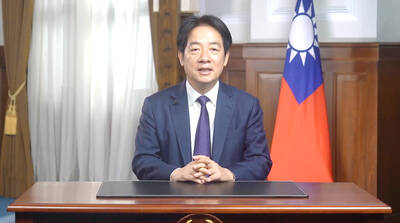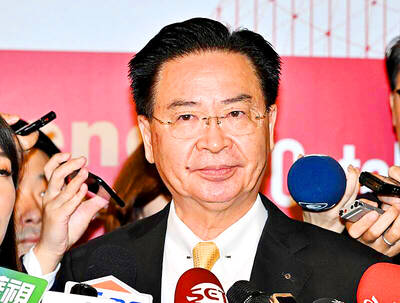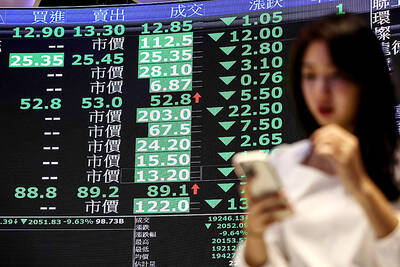Concerns about tech security and COVID-19-related disruptions are propelling companies to move more production away from China, National Development Council (NDC) Minister Kung Ming-hsin (龔明鑫) said.
India and Southeast Asia are the major beneficiaries as more manufacturers try to create two separate supply chains to service Chinese and non-Chinese markets: “red” and “non-red,” Kung said in an interview last month, adding that the trend is accelerating.
“When the US first hit China with stiff tariffs, companies were still a bit hesitant about whether they needed to diversify their supply chains, but following COVID, they realized it is now necessary to shift their production elsewhere,” he said.

Photo: Chen Yi-ling, Taipei Times
China’s stringent COVID-19 policy led to sudden lockdowns, logistics bottlenecks and protests that disrupted production throughout the world’s biggest manufacturing nation. The sudden and sometimes months-long production halts drove home the risks of relying on a single country for global trade, prompting companies to seek other manufacturing bases.
One accelerant was Apple Inc’s projected output cut after workers’ protests turned violent at assembly partner Hon Hai Precision Industry Co’s (鴻海精密) iPhone complex in Zhengzhou late last year.
Since then, the world’s most valuable company has been pushing its suppliers to bolster their manufacturing capabilities outside China, adding more iPhone production capacity in India.
Concerns over tech security are also spurring companies and policymakers, Kung said.
More Taiwanese semiconductor companies might set up factories in India and Southeast Asia, instead of China, he said.
“India has concerns about IT security. It doesn’t want mature chips or low-end products all coming from China,” Kung said.
Even Chinese firms are seeking alternative sources of supplies to better fulfill overseas demand, he said.
“It’s not just Taiwanese companies that need to divide their supply chains,” Kung said. “Chinese companies need to do so too.”

ACTION PLAN: Taiwan would expand procurement from the US and encourage more companies to invest in the US to deepen bilateral cooperation, Lai said The government would not impose reciprocal tariffs in retaliation against US levies, President William Lai (賴清德) said yesterday, as he announced five strategies to address the issue, including pledging to increase Taiwanese companies’ investments in the US. Lai has in the past few days met with administrative and national security officials, as well as representatives from various industries, to explore countermeasures after US President Donald Trump on Wednesday last week announced a 32 percent duty on Taiwanese imports. In a video released yesterday evening, Lai said that Taiwan would not retaliate against the US with higher tariffs and Taiwanese companies’ commitments to

Intelligence agents have recorded 510,000 instances of “controversial information” being spread online by the Chinese Communist Party (CCP) so far this year, the National Security Bureau (NSB) said in a report yesterday, as it warned of artificial intelligence (AI) being employed to generate destabilizing misinformation. The bureau submitted a written report to the Legislative Yuan in preparation for National Security Bureau Director-General Tsai Ming-yen’s (蔡明彥) appearance before the Foreign Affairs and National Defense Committee today. The CCP has been using cognitive warfare to divide Taiwanese society by commenting on controversial issues such as Taiwan Semiconductor Manufacturing Co’s (TSMC, 台積電) investments in the

‘SPECIAL CHANNEL’: Taipei’s most important tasks are to stabilize industries affected by Trump’s trade tariffs and keep negotiations with Washington open, a source said National Security Council Secretary-General Joseph Wu (吳釗燮) arrived in the US for talks with US President Donald Trump’s administration, a source familiar with the matter said on Friday. Wu was leading a delegation for a meeting known as the “special channel,” the Financial Times reported earlier. It marked Trump’s first use of the channel since returning to the White House on Jan. 20. Citing a source familiar with the matter, the Financial Times reported that Minister of Foreign Affairs Lin Chia-lung (林佳龍) was also a part of the delegation. The visit came days after China concluded war games around Taiwan and amid Trump’s

HELPING HAND: The steering committee of the National Stabilization Fund is expected to hold a meeting to discuss how and when to utilize the fund to help buffer the sell-off The TAIEX plunged 2,065.87 points, or 9.7 percent, to close at 19,232.35 yesterday, the highest single-day percentage loss on record, as investors braced for US President Donald Trump’s tariffs after an extended holiday weekend. Amid the pessimistic atmosphere, 945 listed companies led by large-cap stocks — including Taiwan Semiconductor Manufacturing Co (TSMC, 台積電), Hon Hai Precision Industry Co (鴻海精密) and Largan Precision Co (大立光) — fell by the daily maximum of 10 percent at the close, Taiwan Stock Exchange data showed. The number of listed companies ending limit-down set a new record, the exchange said. The TAIEX plunged by daily maxiumu in just